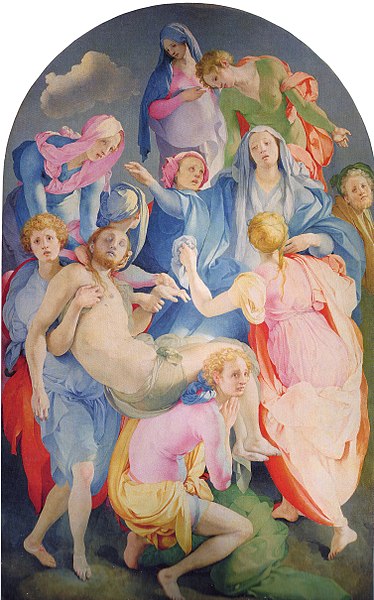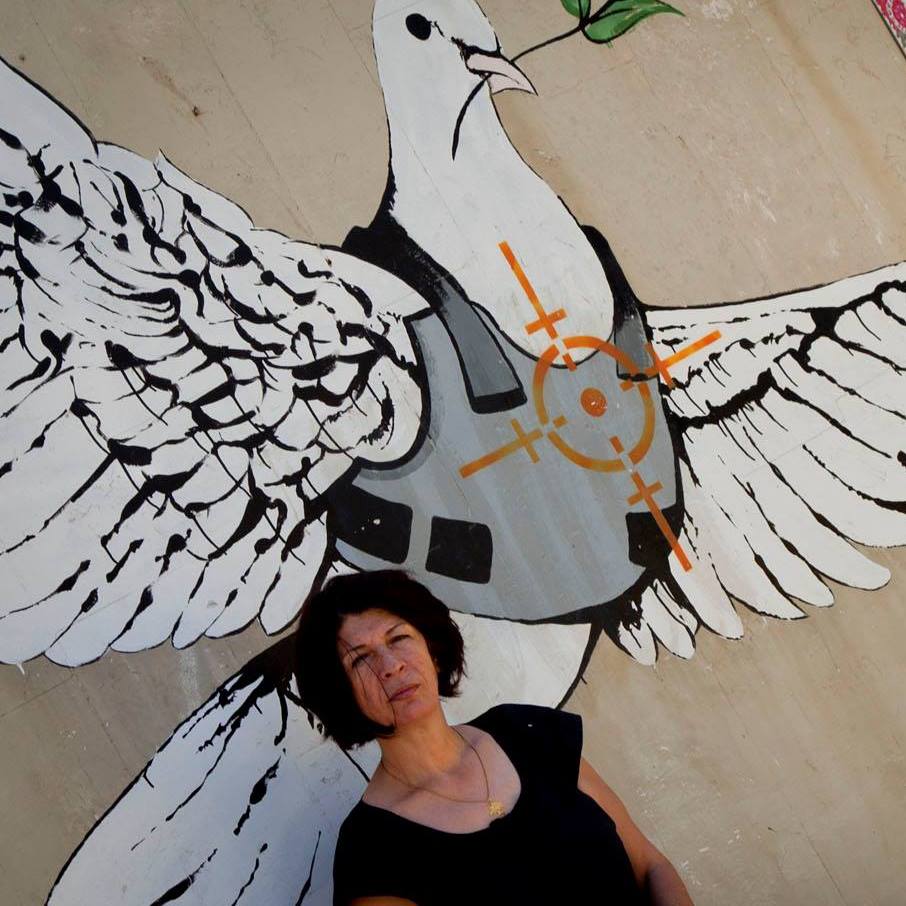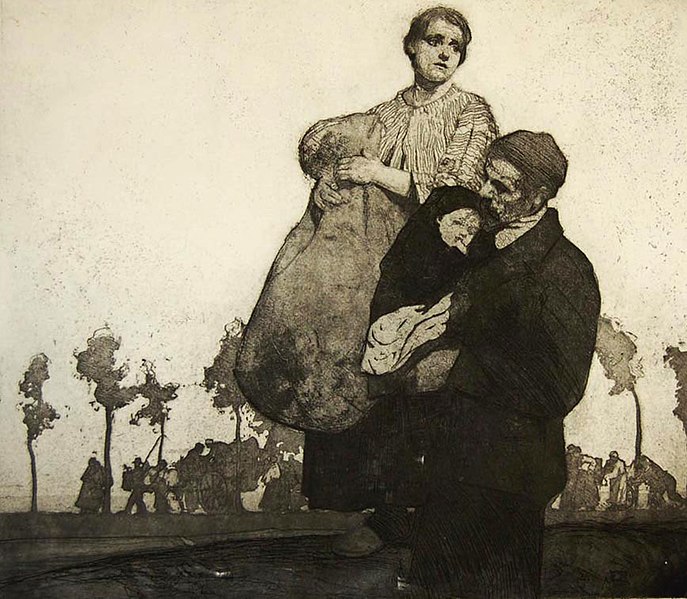
Pontormo (1494–1557)
Portrait of Maria Salviati de' Medici with Giulia de' Medici, circa 1537
Oil on panel
Height: 88 cm (34.6 in). Width: 71.3 cm (28.1 in). Depth: 1 cm (0.4 in).
Maria Salviati was the wife of famous military leader Giovanni delle Bande Nere de' Medici (d. 1526) and the mother of Cosimo I (1519-1574), grand duke of Tuscany. The little girl holding her hand here is probably Giulia, a Medici relative who was left in Maria's care after the murder of the child's father, Duke Alessandro de' Medici (1511-1537).
As Alessandro was born of a liaison between a Medici cardinal and a servant who, tradition has it, was African, this formal portrait may be the first of a girl of African ancestry in European art. The child was painted over sometime during the 19th century but was rediscovered during a 1937 cleaning of the work.
Although Maria still wears the clothing of mourning for her deceased husband, Pontormo's elegant style conveys her aristocratic grace through her impossibly long fingers and her fashionably pale color (indicative of a life led out of the sun), which she shares with Giulia.
Pontormo was the son of Bartolommeo Carrucci, a painter. According to the biographer Giorgio Vasari, he was apprenticed to Leonardo da Vinci and afterward to Mariotto Albertinelli and Piero di Cosimo. At the age of 18 he entered the workshop of Andrea del Sarto, and it is this influence that is most apparent in his early works. An example of Pontormo's early style is a fresco depicting the Visitation of the Virgin and St Elizabeth, with its dancelike, balanced figures, painted from 1514 to 1516.

Pontormo (1494–1557)
Visitation of the Virgin and St Elizabeth, c. 1514-1516
Fresco
392 × 337 cm (154.3 × 132.7 in)
Santa Annunziata, Florence
The Visitation is the visit of Mary with Elizabeth as recorded in the Gospel of Luke, Luke 1:39–56. It is also the name of a Christian feast day commemorating this visit, celebrated on 31 May in the West (2 July in calendars of the 1263–1969 period, and in the modern regional calendar of Germany as well as the Anglican Communion) and 30 March among Eastern Christians. More
This early Visitation makes an interesting comparison with his painting of the same subject (below), which was done about a decade later for the parish church of St. Michael in Carmignano, about 20 km west of Florence. Placing these two pictures together—one from his early style, and another from his mature period—throws Pontormo's artistic development into sharp relief. In the earlier work,
Pontormo (1494–1557)
Visitation, c.1529
Oil on Wood
20.2 x 15.6 cm
Church of San Francesco e Michele, Carmignano, Italy
In 1518 he completed an altarpiece in the Church of San Michele Visdomini, Florence, that reflects in its agitated—almost neurotic—emotionalism a departure from the balance and tranquillity of the High Renaissance. His painting of Joseph in Egypt (c. 1515), one of a series for Pier Francesco Borgherini, suggests that the revolutionary new style appeared even earlier.

Pontormo (1494–1557)
Joseph in Egypt, c. 1517-1518
Oil on canvas
44 × 49 cm (17.3 × 19.3 in)
National Gallery in London
The Joseph canvases offer another example of Pontormo's developing style. Done around the same time as the earlier Visitation, these works (such as Joseph in Egypt, above) show a much more mannerist leaning. According to Giorgio Vasari, the sitter for the boy seated on a step is his young apprentice, Bronzino.
Pontormo (1494–1557)
Martyrdom of St Maurice and the Theban Legion, c. 1528-30
Oil on wood
65 x 73 cm
Galleria Palatina (Palazzo Pitti), Florence
This picture represents a mass slaughter, including a series of crucifixions in the background. The battle scene on the left side of the panel recalls Leonardo's cartoon for the Battle of Anghiari, known today only through copies. Elsewhere there are reflections of Michelangelo's work, including the cartoon for the Battle of Cascina. Nevertheless, Pontormo always retains his own voice. More
Pontormo was primarily a religious painter, but he painted a number of sensitive portraits and in 1521 was employed by the Medici family to decorate their villa at Poggio a Caiano with mythological subjects.
Pontormo (1494–1557)
Christ before Pilate, c. 1523-25
Fresco
300 x 290 cm
Certosa, Galuzzo
In the Passion cycle (1522–25) (above) for the Certosa near Florence, he borrowed ideas from the German artist Albrecht Dürer, whose engravings and woodcuts were circulating in Italy. His mature style is best exemplified in the Deposition (below) painted soon after this for Santa Felicità, Florence.
Jacopo Pontormo
Madonna and Child with the Young Saint John, c. 1527
Oil on Wood
Galleria degli Uffizi, Florence, Italy
The figures are solid and well-defined, and the chiaroscuro, rendered with feeling, moulds the golden flesh surfaces with a yellowish light. More

Pontormo (1494–1557)
The Deposition, from 1526 until 1528
Oil on canvas
313 × 192 cm (123.2 × 75.6 in)
Chiesa Santa Felicità, Florence
This painting suggests a whirling dance of the grief-stricken. They inhabit a flattened space, comprising a sculptural congregation of brightly demarcated colors. The vortex of the composition droops down towards the limp body of Jesus off center in the left. Those lowering Christ appear to demand our help in sustaining both the weight of his body (and the burden of sin Christ took on) and their grief. No Cross is visible; the natural world itself also appears to have nearly vanished: a lonely cloud and a shadowed patch of ground with a crumpled sheet provide sky and stratum for the mourners. If the sky and earth have lost color, the mourners have not; bright swathes of pink and blue envelop the pallid, limp Christ. More
Pontormo (1494–1557)
Madonna and Child with Saints, c. 1518
Oil on wood
214 x 185 cm
San Michele Visdomini, Florence
Pontormo executed this painting for the chapel of Francesco di Giovanni Pucci in the church San Michele Visdomini in Florence. The painting, usually mentioned as the Pucci Altarpiece, portrays the Virgin with St John the Evangelist, Joseph, holding the baby Jesus, the young St John, St Francis and St James, the latter being the artist's self-portrait.
The figures are arranged in two areas, divided by a vertical axis, which forms the height of a triangle, at whose apex is the Virgin's head.
The compositions of both the right part and the left part, although symmetrical and populated by an identical number of figures, are organized very differently. The complex twisting of the bodies and the many different directions of the gestures suggest the use of a grid of extremely complicated and dynamic geometrical schemes. The lines of vision go in all possible directions; in no instance do they cross or match, this emphasizing the psychological isolation of the figures. The facial features and expressions of the older Joseph and St John the Evangelist, as well as the laughing putti, are exaggeratedly pronounced. In short, everything combines to create an atmosphere of restless instability. More
Pontormo (1494–1557)
Madonna and Child with St. Joseph and Saint John the Baptist, c. 1521-27
Oil on canvas transferred from wood
120 x 99 cm
The Hermitage, St. Petersburg
In this superb example of Pontormo's style, the theme of a premonition of the predestined Passion grows smoothly from the centre to the edges and from the surface into the depth. From the infant amusing himself wit a young goldfinch, our gaze shifts to the Virgin's sad face, then to the resigned faces of Joseph and John the baptist, before finally plunging into the agitated gloom of the firmament, in front of the ominous cross looms More
Pontormo became more and more of a recluse in later life. A diary survives from 1554 to 1557, but the important frescoes in San Lorenzo on which he worked during the last decade of his life are now known only from drawings; in these the influence of Michelangelo is apparent. Numerous drawings survive, and paintings are to be found in various galleries in Europe and America, as well as in Florence.
Pontormo (1494–1557)
The Annunciation detail Virgin Annunciate, c. from 1527 until 1528
Fresco
Capponi Chapel, church of Santa Felicita in Florence
It is frescoed around the window on the wall adjacent to Pontormo's masterpiece, the famous Deposition from the Cross. Pontormo depicts the Annunciation, the revelation to Mary by the Archangel Gabriel that she would conceive a child to be born the Son of God, in a lively composition, with both figures in an elastic contrapposto. More
Pontormo (1494–1557)
Venus and Cupid, c. 1532-34
Oil on wood
128 x 197 cm
Galleria degli Uffizi, Florence
Venus turns her massive body into the picture plane, confronting the viewer with it and with the incestuous kiss she gives her young son - a juxtaposition recalling more conventional allegories of Charity. Her coolly classical face resembles the second of the two masks, symbols of the misleading nature of dreams. More
Acknowledgement: Wikipedia, Britannica,








